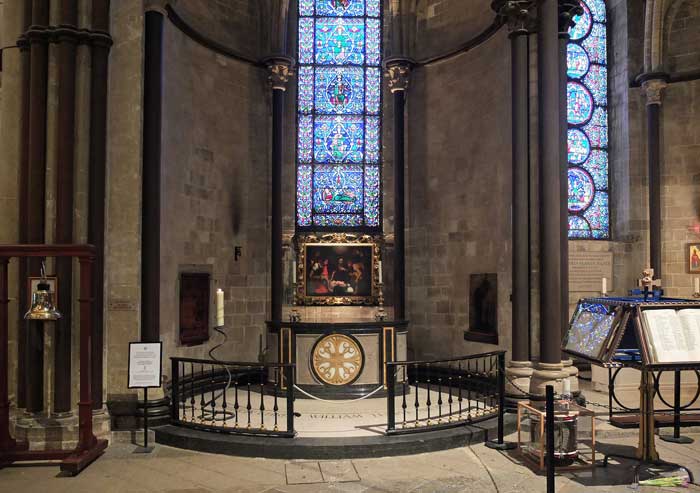Archbishop of Canterbury (1942-1944)
William Temple was described by a contemporary as, “a philosopher, theologian, social teacher, educational reformer, and the leader of the ecumenical movement of his generation”. He was the second son of Frederic Temple, a previous Archbishop of Canterbury (1896-1902) whose memorial lies on the south side of the Corona. William Temple was archbishop during the Second World War when he supported a negotiated peace. From infancy he was a life-long sufferer from gout, which finally attributed to his death in office while resident at Westgate-on-Sea. He was the first archbishop to be cremated and his ashes were buried in the Great Cloister garth, close to his father’s grave.
The Chapel of St John was dedicated in his memory. The altar and communion rails were designed by Stephen Dykes Bower and his plans submitted to the Dean and Chapter in September 1950, immediately prior to his becoming the Surveyor of the Fabric to Westminster Cathedral. The memorial is oval in conception and although the altar rail design was changed, the colour palette and design of the altar was approved; the black of the altar seeming to echo the dark Purbeck Marble shafts of the chapel’s architecture.
The altar and rails are probably carved from a Belgian Black Limestone, a variety known as Petit Granit.
The yellow rectangular inlay side strips and the raised intricate central design are carved from a yellow marble. This is likely to be Giallo di Siena a marble from the Province of Siena in the Italian region of Tuscany. The best quality stone is said to have been quarried at Montarrenti, near the town of Sovicille, not far from Sienna. The colour is derived from varying quantities of iron minerals present in the form of goethite and limonite. The marble is quarried from the Tuscan Metamorphic Complex, part of the Apennine Mountains.
The beige arcuate front panels and the two side panels are constructed from limestone quarried in the province of Trieste on the Italian-Slovenian border. It is one of the Repen limestones named after the village of Repen and known as Repen Zola. It is a compact limestone composed of fossil shells set within a carbonate mud. The shells are mainly those of rudists and other bivalves, whole and fragmented, that lived on a tropical carbonate platform during the Upper Cretaceous. The limestone was later partly recrystalised. The stone is still quarried.
The unfussy inscription “Remember in Christ William Temple Archbishop” is inscribed upon the pavement before the altar, again probably from Belgian Black Limestone.

